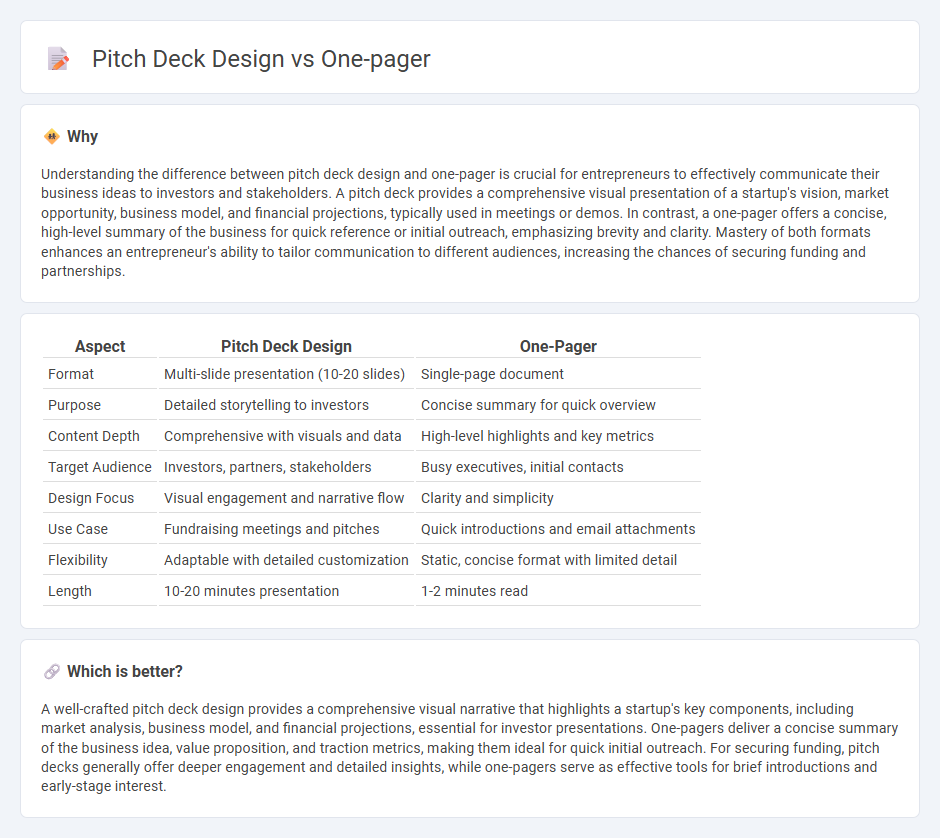
Pitch deck designs emphasize visually engaging storytelling with concise data points and impactful graphics to capture investor interest quickly. One-pagers focus on summarizing key business insights, financial highlights, and value propositions in a succinct, easy-to-scan format. Discover how to tailor your content for maximum investor appeal and clarity.
Why it is important
Understanding the difference between pitch deck design and one-pager is crucial for entrepreneurs to effectively communicate their business ideas to investors and stakeholders. A pitch deck provides a comprehensive visual presentation of a startup's vision, market opportunity, business model, and financial projections, typically used in meetings or demos. In contrast, a one-pager offers a concise, high-level summary of the business for quick reference or initial outreach, emphasizing brevity and clarity. Mastery of both formats enhances an entrepreneur's ability to tailor communication to different audiences, increasing the chances of securing funding and partnerships.
Comparison Table
| Aspect | Pitch Deck Design | One-Pager |
|---|---|---|
| Format | Multi-slide presentation (10-20 slides) | Single-page document |
| Purpose | Detailed storytelling to investors | Concise summary for quick overview |
| Content Depth | Comprehensive with visuals and data | High-level highlights and key metrics |
| Target Audience | Investors, partners, stakeholders | Busy executives, initial contacts |
| Design Focus | Visual engagement and narrative flow | Clarity and simplicity |
| Use Case | Fundraising meetings and pitches | Quick introductions and email attachments |
| Flexibility | Adaptable with detailed customization | Static, concise format with limited detail |
| Length | 10-20 minutes presentation | 1-2 minutes read |
Which is better?
A well-crafted pitch deck design provides a comprehensive visual narrative that highlights a startup's key components, including market analysis, business model, and financial projections, essential for investor presentations. One-pagers deliver a concise summary of the business idea, value proposition, and traction metrics, making them ideal for quick initial outreach. For securing funding, pitch decks generally offer deeper engagement and detailed insights, while one-pagers serve as effective tools for brief introductions and early-stage interest.
Connection
Pitch deck design and one-pager are connected as essential tools for entrepreneurs to communicate their business ideas succinctly and attract investors. A well-crafted pitch deck provides a detailed visual narrative of the startup's value proposition, market opportunity, and financial projections, while the one-pager offers a concise summary highlighting key points. Both must align in messaging and branding to effectively support fundraising efforts and stakeholder engagement.
Key Terms
Clarity
One-pager designs prioritize clarity by distilling key information into a concise, visually appealing layout that highlights the core value proposition and essential metrics. Pitch decks expand on clarity by presenting a structured narrative, combining concise text with impactful visuals to guide the audience through problem, solution, market opportunity, and financial projections. Explore detailed strategies to enhance clarity in both one-pager and pitch deck designs for maximum investor impact.
Visual Hierarchy
Effective visual hierarchy in one-pager design emphasizes clarity by prioritizing key information through size, color, and placement, ensuring quick comprehension. Pitch decks require a balanced visual hierarchy that guides the audience through a narrative flow while highlighting essential data points and calls to action. Explore best practices to enhance your one-pager and pitch deck visuals for stronger engagement.
Key Metrics
Key metrics in one-pager design are presented concisely to capture immediate interest, emphasizing essential data such as revenue growth, customer acquisition cost (CAC), and lifetime value (LTV) in a visually digestible format. Pitch decks, however, incorporate key metrics within a broader narrative context, using charts and infographics to highlight traction, market opportunity, and unit economics for investor persuasion. Explore deeper strategies to optimize key metrics presentation and enhance storytelling in your fundraising materials.
Source and External Links
How to Create a Compelling One-Pager: 5-Step Method - A one-pager is a single-page document that distills key information to enable swift decision-making, targeted pitches, and follow-up after presentations by addressing specific audience needs clearly and concisely.
What is a business one-pager + free template | Acrobat for business - A business one-pager summarizes essential business elements such as mission, value proposition, products, market info, metrics, team, and contact details, offering a clear, concise snapshot designed to effectively communicate key messages on a single page.
A Simple Trick for Success with One-Pagers | Cult of Pedagogy - In education, a one-pager is a creative student assignment where learners summarize key takeaways from diverse sources on a single page, combining text and images to enhance memory and understanding.
 dowidth.com
dowidth.com